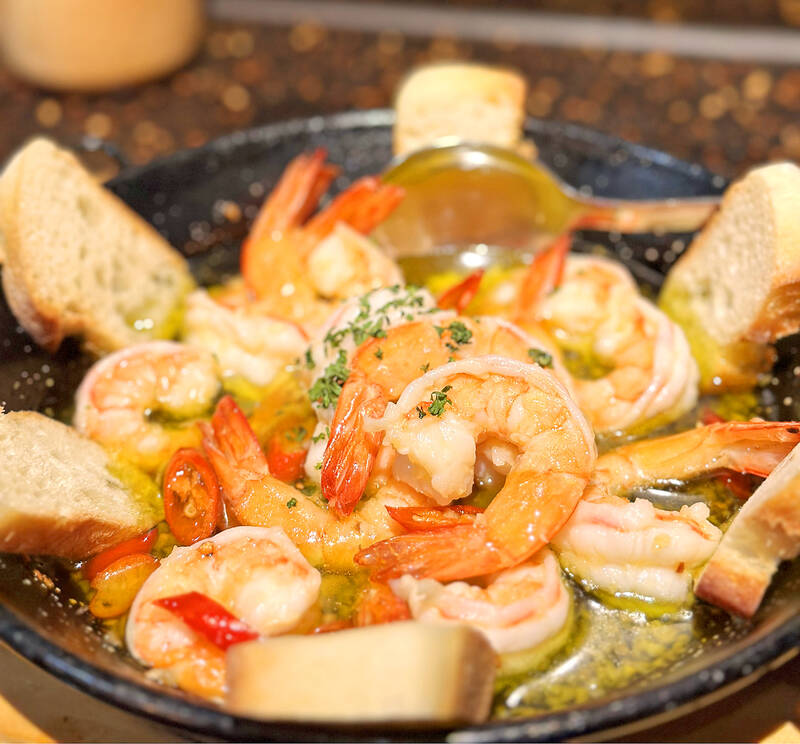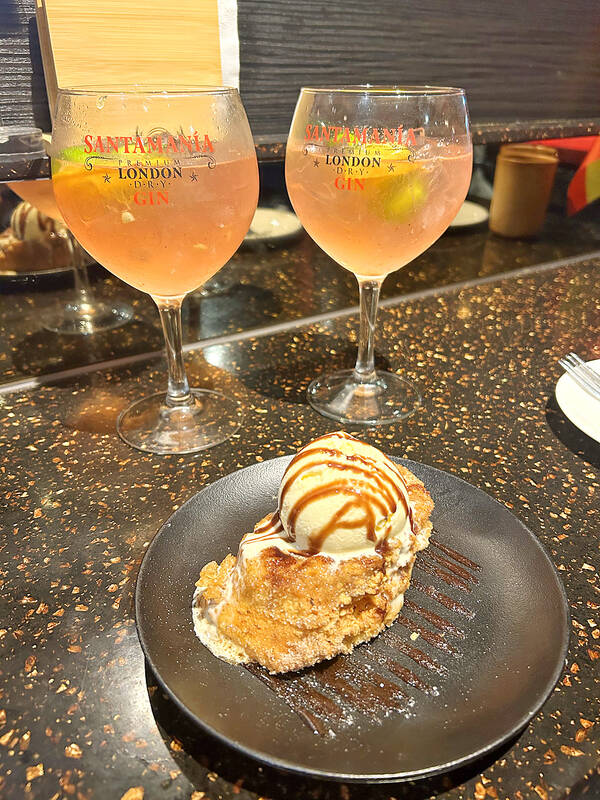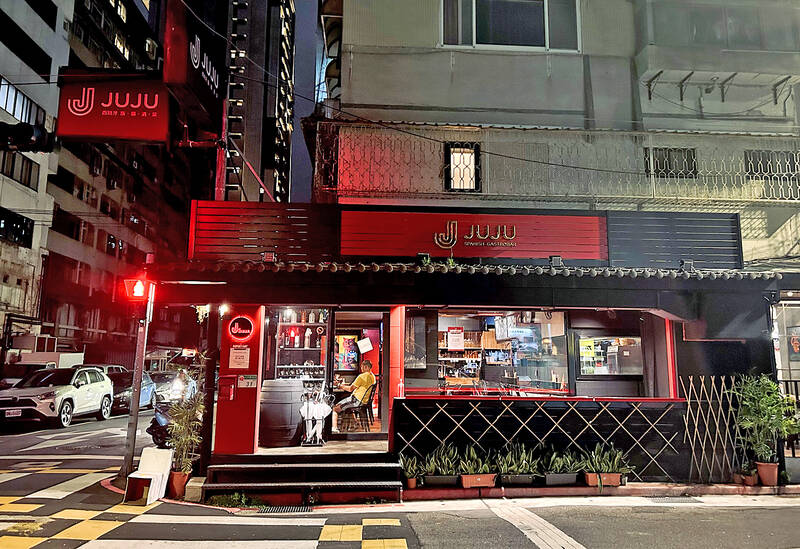Dimmed red lighting and cozy corners, the soft glow from the streetlights outside; the music, modern yet sexy, envelops hushed conversations. JUJU entices us to their snug Spanish spot to clink wine glasses and share indulgent dishes. This place was designed for sultry romantic evenings.
But be warned: the tapas use an atomic bomb of garlic, a daring choice for date night.
Entering from a rainy night in Songshan District (松山), we’re hit with that intoxicating garlic and the warmth of a charming bistro hitting the sweet spot between busy and bustling. I was looking to impress, and I hit the jackpot.

Photo: Hollie Younger
Hailing from the volcanic island paradise of Tenerife, Spanish native chef Pablo Lorenzo floats around the dining area, offering recommendations, mixing drinks and whipping up delicious small plates in the open kitchen.
Entering their seventh year, JUJU is a family affair of passion and perfection. Except for the fresh produce, their beers and wines, spices and aromatics, even the charcuterie and cheeses are imported from Spain. Lorenzo’s cousin, a professional jamon slicer, regularly flies to Taipei with certified Iberico ham and supplies JUJU’s charcuterie boards with the premium cuts, cured for 36 or 48 months and carved into silky, salty slices, straight off the leg. A plate of Iberico ham (NT$900) with a jug of fresh sangria (NT$590) forms the perfect introduction to this leisurely and intimate culinary experience.
Many sangrias are in fact an amateur amalgamation of red wine and soggy fruit. But JUJU’s sharing jars are a one-way ticket to a sunny veranda in Seville, a holiday in a glass. Pablo also imports gin from the Balearic Islands, using a traditional and simple Menorca-made gin for JUJU’s signature gin and tonic (NT$320), elevated in-house with rosemary and berries for a light, summery spritz.

Photo: Hollie Younger
In homage to his Canary Island home, located off of continental Africa, Lorenzo’s menu fuses Spanish classics with fresh seafood and South American flavors; his menu features Venezuelan arepas, akin to a taco with a starchy, maize dough casing.
The more continental tapas list offers a wide range from classic croquettes to more opulent braised octopus; Lorenzo recommends sharing three to four per couple.
The signature here, that Lorenzo implores we try, are the garlic shrimp (NT$550). Served in an individual cast-iron pan, the shrimp are plump and pink, doused in rich garlic oil amplified with fresh red chili. Loaded onto the crisp toasts, it’s a yummy mouthful.

Photo: Hollie Younger
Our next order from the sea is the seafood paella (NT$430), conveniently served tapas-size in miniature pans. The mussels are huge, the clams juicy and we’re delighted with a further helping of those fresh prawns.
The final tapas; Beef Tongue Pintxos (NT$360). In northern Spain’s Basque region, traditional taverns serve bite sized appetizers on tiny crispy toast: the pintxo. JUJU’s take uses ample slices of tender, buttery beef tongue on a bed of soft and tangy cream cheese. It’s incredibly rich, but strikes just the right balance — good things come in small portions.
Think tapas, and desserts don’t usually come to mind, but a hugely popular dish is the Torrijas (NT$280). Bread soaked in cinnamon milk and fried, it’s the cakier, fluffier cousin of the churro, topped with vanilla ice cream. A little something sweet sees off a smorgasbord of authentic, bold Spanish cuisine — full-bodied flavors yet never too heavy.

Photo: Hollie Younger
We finish the evening watching the world go by from the covered terrace, savoring the last of a fruity gin and tonic as we reacclimatize from sunny Spain to rainy Taipei.

Photo: Hollie Younger

May 26 to June 1 When the Qing Dynasty first took control over many parts of Taiwan in 1684, it roughly continued the Kingdom of Tungning’s administrative borders (see below), setting up one prefecture and three counties. The actual area of control covered today’s Chiayi, Tainan and Kaohsiung. The administrative center was in Taiwan Prefecture, in today’s Tainan. But as Han settlement expanded and due to rebellions and other international incidents, the administrative units became more complex. By the time Taiwan became a province of the Qing in 1887, there were three prefectures, eleven counties, three subprefectures and one directly-administered prefecture, with

It’s an enormous dome of colorful glass, something between the Sistine Chapel and a Marc Chagall fresco. And yet, it’s just a subway station. Formosa Boulevard is the heart of Kaohsiung’s mass transit system. In metro terms, it’s modest: the only transfer station in a network with just two lines. But it’s a landmark nonetheless: a civic space that serves as much more than a point of transit. On a hot Sunday, the corridors and vast halls are filled with a market selling everything from second-hand clothes to toys and house decorations. It’s just one of the many events the station hosts,

Two moves show Taichung Mayor Lu Shiow-yen (盧秀燕) is gunning for Chinese Nationalist Party (KMT) party chair and the 2028 presidential election. Technically, these are not yet “officially” official, but by the rules of Taiwan politics, she is now on the dance floor. Earlier this month Lu confirmed in an interview in Japan’s Nikkei that she was considering running for KMT chair. This is not new news, but according to reports from her camp she previously was still considering the case for and against running. By choosing a respected, international news outlet, she declared it to the world. While the outside world

Through art and storytelling, La Benida Hui empowers children to become environmental heroes, using everything from SpongeBob to microorganisms to reimagine their relationship with nature. “I tell the students that they have superpowers. It needs to be emphasized that their choices can make a difference,” says Hui, an environmental artist and education specialist. For her second year as Badou Elementary’s artist in residence, Hui leads creative lessons on environmental protection, where students reflect on their relationship with nature and transform beach waste into artworks. Standing in lush green hills overlooking the ocean with land extending into the intertidal zone, the school in Keelung